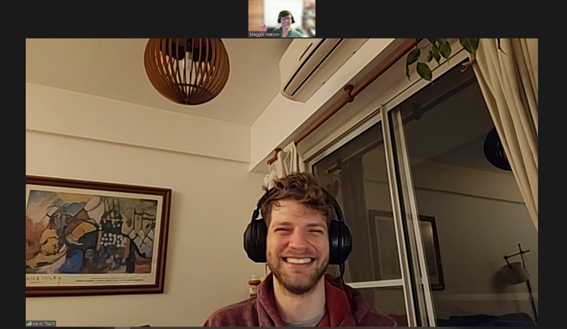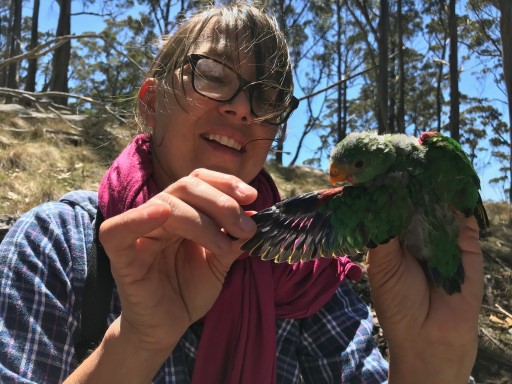This blog post is also available in Spanish here.
Authors Kevin Tkach and Maggie Watson recall how they kept their focus when lockdowns in both countries prevented their meeting in-person to work on a PhD project. Instead, over a three-year period, they worked together on a systematic review trying to understand how conservation genetics tools were applied to conservation problems.
How the project begun
Before the lockdown Kevin contacted Maggie to suggest they do a PhD together. Kevin had seen Maggie’s Twitter postings under her handle @terngirl. Kevin was deeply interested in conservation applications and management relating to birds. Kevin had just completed a degree in Ecology writing a thesis on parental investment of the fork-tailed flycatcher Tyrannus savana and was working on a research group at the University of Buenos Aires on monitoring invasive mammals. He was keen to work in Australia on projects that Maggie was working on; at the time she was studying conditioned taste aversion with Krefft’s gliders Petaurus notatus and swift parrot Lathamus discolor eggs.

Soon after that first contact, COVID-19 started rolling across the globe. Email discussions continued, and we considered various potential PhD projects from freshwater crayfish Euastacus sp. and impacts of feral horses to invasive hedgehogs and native lizards in New Zealand. All these discussions had one theme – the application of genetics tools to a specific conservation problem.
Despite the threats of lockdowns, we decided to start on the literature review (a requirement of an Australian PhD), and settled on the key question we would ask, “With all of the genetics tools available, how many are actually being used in conservation?”.
Remote working
Lockdowns in Argentina started on March 20th 2020, and lasted 318 days. Kevin was desperate for something to do during this time, so we expanded the scope of the literature review to a much broader and far-reaching systematic review.
In the end, Kevin trawled through 53,767 scientific articles of all kinds, from peer reviewed publications, doctoral and graduate theses, as well as technical publications from governmental and non-governmental conservation agents to newspaper clippings. We met weekly over Zoom throughout this time and discovered a mutual love of sports! And dogs! And nature! And fun Zoom backgrounds!

© https://www.starwars.com/news/star-wars-backgrounds
Identifying problems
First, we identified the management problems that conservation genetics could address, and then we looked at the management applications of various conservation genetics tools. Then, we assigned papers to these categories. We ended up with a very large, very colourful Excel spreadsheet with words like “failure” and “success” scattered around.
The biggest surprise was the fact that so few studies met the criteria of reporting on the use of an applied conservation genetics tool on a wildlife species. Of the thousands of articles we looked at, only 115 studies met the criteria of reporting on the use of an applied conservation genetics tool on a wildlife species.
This was an appalling number.
Of these 115, a total of 49 met the criteria of outcome- or intervention-based use of applied conservation genetics. The remaining 66 articles did not meet the criteria of the use of applied conservation genetics tools for wildlife conservation, but, in general, made recommendations that a conservation genetics tool be used in an applied sense.
We did see that research on conservation genetics has increased gradually over the last 30 years, but only 0.09% of the total number of articles searched had an on-ground applied application or outcome from the use of a conservation genetics tool.
Again, an appallingly low percentage.
Search engine restrictions
Not unexpectedly, the spatial distribution of the 49 applied conservation genetics studies was biased towards North America and Europe, closely followed by Australia and New Zealand. South America, Africa and most of Asia showed almost no indication that conservation genetics work was being conducted.
Clearly this is not reality. Because of the restrictions on search engine availability (everything but Google Scholar, Scopus, Medline and SciELO were behind paywalls) and the fact that we searched only in English, Spanish and Portuguese, we knew that we had missed many potential studies. We tried to put ourselves in the shoes of a researcher from a country that did not have access to “amazing” search engines – probably a restriction on most conservation managers in the world today. This put our findings in a whole new light. All of this work is locked away, untouchable by those managers that need to see it most.
Examining our 115 studies more closely, we determined that most of the studies concluded with recommendations to use a conservation genetics tool for management of a particular species. But finding a subsequent publication where the recommendation was explicitly translated into an intervention was often difficult, even when searching in the grey literature.
This bias towards recommendations rather than actual use of the tool towards an intervention is not unexpected given the known time-lag between research and publication. While we attempted to find as much grey literature on the application of conservation genetics, we have to acknowledge that many reports remain unpublished, uncited and unavailable to all but species managers.
Recommendations
In the end, we came up with three explicit recommendations:
- A repository of information about the use and implementation of conservation genetics tools must be developed. We envision that this could be modelled after Conservation Evidence or GenBank, so it is updatable and searchable.
- Funding and publication need to reflect geographic and taxonomic biases. More work needs to be done in countries other than the Global North and on species other than fish, mammals and birds.
- Conservation work should focus on species most in need, those that the IUCN has identified as threatened (our review found that most work was conducted on IUCN Least Concern species).
Improving our search strategy
After the early view publication of our article, a researcher in the field of conservation genetics wrote to us and asked why their studies had not been included in our systematic review. We explained that the omission may have been a function of our search strategy.
One of the points we hoped to make with this review was that despite intensive searching, we missed a lot. Perhaps it was because of key words or the search engines we used. What this ultimately means is that a naïve manager looking for information is simply not going to find it by looking for peer-reviewed papers.
But more specifically, the researcher’s papers did not meet our “applied” definition. They made recommendations, but we could not find any evidence that their genetics-tool-based recommendation had been applied. The researcher wrote back and said that their work had been included in the national action plan for the species, but everything was unfortunately unpublished.
In the end, we hope that other conservation geneticists out in the world doing good work recognise that the “conservation genetics publishing bias” we have identified is a real problem and will work to report and publish on follow up actions based on their initial recommendations.
A job well done.
Read the full article “Publication and use of genetic tools in conservation management applications – A systematic review” in Journal of Applied Ecology





2 thoughts on “Editor’s Choice 60:8 Twitter, Covid-19 lockdowns and a systematic review”